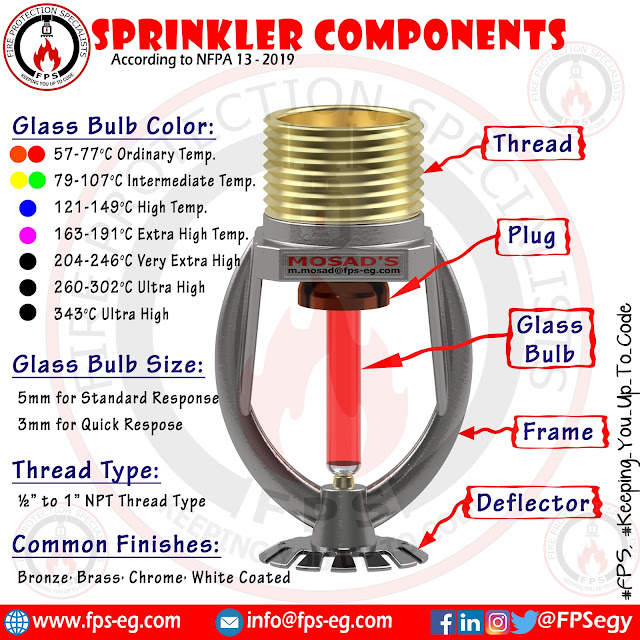Sprinkler Characteristics According to NFPA 13
Sprinkler Characteristics According to NFPA 13 - 2019 Edition
 |
Sprinkler Characteristics According to NFPA 13 - 2019 Edition |
What is Automatic Sprinkler?
A fire suppression or control device
that operates automatically when its heat-activated element is heated to its
thermal rating or above, allowing water to discharge over a specified area.
What are the components of Automatic Sprinklers?
Sprinkler components are showed in the following figure:
 |
Sprinkler Characteristics According to NFPA 13 - 2019 Edition |
How Automatic sprinkler works?
the video below illustrates the components and the principle of operation of automatic sprinklers:
What is Sprinkler Identification Number (SIN)?
SIN consists of one or two characters
identifying the manufacturer, followed by three or four digits to uniquely
identify a sprinkler characteristics such as K-factor, deflector
characteristic, pressure rating, and thermal sensitivity.
What is Thermal Sensitivity of Automatic Sprinklers?
A measure of the rapidity with which the
thermal element operates as installed in a specific sprinkler or sprinkler
assembly.
One measure of thermal sensitivity is
the response time index (RTI).
Value of RTI shall be as followings:
(a) For RTI of 50 (meters-seconds)1∕2 or
less, sprinkler is defined as fast response
(b) For RTI of 80 (meters-seconds)1∕2 or
more, Sprinkler is defined as standard response.
(c) For RTI greater than 50 and less
than 80 (meters-seconds)1∕2, sprinkler is defined as special response.
What are Sprinkler Discharge Characteristics?
Sprinkler K-factor, and thread type
shall be in accordance with the following table according to NFPA 13:
 | |
|
What are Temperature Characteristics of Automatic Sprinklers?
Automatic sprinklers shall have their
frame arms, deflector, coating material, or liquid bulb colored in accordance
with the requirements of the following table
 |
Sprinkler Characteristics According to NFPA 13 - 2019 Edition |
What are the Available Installation Orientation of Automatic Sprinklers?
Pendent Sprinkler:
A sprinkler designed to be installed in such a way that the water stream is directed downward against the deflector.Upright Sprinkler:
A sprinkler designed to be installed in such a way that the water spray is directed upwards against the deflector.Sidewall Sprinkler:
A sprinkler having special deflectors that are designed to discharge most of the water away from the nearby wall in a pattern resembling one quarter of a sphere, with a small portion of the discharge directed at the wall behind the sprinkler.Concealed Sprinkler:
A recessed sprinkler with cover plate.Flush Sprinkler:
A sprinkler in which all or part of the body, including the shank thread, is mounted above the lower plane of the ceiling.Recessed Sprinkler:
A sprinkler in which all or part of the body, other than the shank thread, is mounted within a recessed housing.What are Sprinkler Types defined according to design and performance characteristics?
Spray Sprinkler:
A type of sprinkler listed for its capability to provide fire control for a wide range of fire hazards. Spray sprinklers are available in two categories, Standard spray and extended coverage sprinklers.Quick-Response (QR) Sprinkler:
A type of spray sprinkler that has a thermal element with an RTI of 50 (meter-seconds)1∕2 or less.Control Mode Density/Area (CMDA) Sprinkler:
A type of spray sprinkler intended to provide fire control in storage applications using the design density/area criteria.Control Mode Specific Application (CMSA) Sprinkler:
A type of spray sprinkler that is capable of producing characteristic large water droplets and that is listed for its capability to provide fire control of specific high-challenge fire hazards.Early Suppression Fast-Response (ESFR) Sprinkler:
A type of fast-response sprinkler that has a thermal element with an RTI of 50 (meters-seconds)1∕2 or less and is listed for its capability to provide fire suppression of specific high challenge fire hazards.Nozzle:
A device for use in applications requiring special water discharge patterns, directional spray, or other unusual discharge characteristics.Open Sprinkler:
A sprinkler that does not have actuators or heat-responsive elements.Residential Sprinkler:
A type of fast-response sprinkler having a thermal element with an RTI of 50 (meters-seconds)1∕2 or less that has been specifically investigated for its ability to enhance survivability in the room of fire origin and that is listed for use in the protection of dwelling units.References of this article:
NFPA 13 - 2019 edition (Standard of Installation of Automatic Sprinklers)
Read Also:
Sprinklers Installation & Omission In Electrical RoomsPipe Schedule for Sprinklers Above & Below Ceiling
Return Bend Requirements For Sprinkler Systems
Distance Below Ceiling For Standard Pendant & Upright Sprinklers
Sprinklers Positioning In Angled & Irregular Shaped Rooms
Sprinkler Distribution In Small Rooms











SIN consists of one or two characters identifying the manufacturer, followed by three or four digits to uniquely identify a sprinkler characteristics such as K-factor, deflector characteristic, pressure rating, and thermal sensitivity.
ReplyDeleteengagement party ideas at home
backyard engagement party ideas
For many people this is important, so check out my profile: sprinkler repair
ReplyDelete